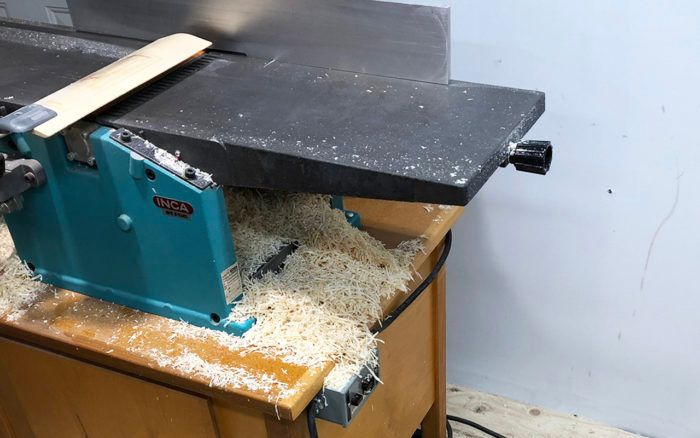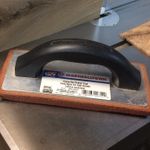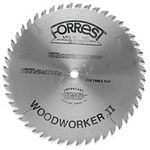Which first, jointer or planer?
It's a tough question. Vic Tesolin argues that if you're armed with a jack plane, the answer is obvious.

Whether you are just starting out on a wonderful woodworking journey or perhaps looking to upgrade some equipment, deciding where to put your hard-earned cash can be stressful. A common question I get asked is which tool to buy first: a jointer or a thickness planer.
My advice is almost always to get a thickness planer first. I know at first blush this may seem like bad advice because when initially processing lumber, we should get one flat face and one true edge. This first step presumably requires a power jointer, but consider this…
A jointer’s first job is to flatten a board’s face. Then you can use that face to reference against the fence to get an edge 90° to that face. If you have a 6- or 8-in. jointer and are working with 6-in.- or 8-in.-wide boards, then this is totally achievable. But what about boards wider than your jointer’s width capacity? I often work with boards that are wider than 8 in., so to my mind, a 6- or 8-in. jointer won’t do the trick.
Most people have a budget for the amount they spend on tools. At the time of this writing, a mid-line 6-in. jointer will set you back between $500 and $1,000. Bump up to an 8-in. jointer and you can safely double the price to the $2,000 range. If you start looking at machines that are 12 in. and larger, you’ll be laying out $4,500 and up.
As far as electrics are concerned, most 6-in. jointers will run on 110-volt power, while 8-in. jointers often require a bump up to 220-volt power—a step that often requires some new wiring to be installed. Bigger machines often need 3-phase power. Things get serious at this point; trying to feed these machines requires phase converters or installing 3-phase power in your home shop.
Enter the trusty jack plane. This workhorse can easily flatten boards up to 500mm (20 in.) wide and can do it quickly. You aren’t trying to make a pristine surface when flattening a board with a plane, you’re simply trying to get it flat. Once flat, that surface can be used as a reference surface on the bed of a thickness planer. After that, you can flip the board for the last few passes on the planer to get rid of your jack plane marks. That same plane can be used to joint the edges of the board. With a little bit of practice, the jack plane can do a lot for a woodworker.
For many, including myself, there is little joy surrounding thicknessing boards by hand. For this reason, I choose to flatten my boards by hand and then stuff them into the thickness planer to bring them to final thickness. I didn’t own a power jointer for many years because I didn’t want to buy anything smaller than a 10-in. machine. I waited patiently and finally found my current jointer, a vintage Inca 570 that has a 260mm (10-1/4 in.) capacity, which suits my needs quite well.
Fortunately, combo machines are starting to become more common here in North America, so that is a great option for people interested in these machines. If you’re not interested in a combo machine, the jack plane could be a good solution for you.
In order to understand, you must do. – V
 |
|
 |
|
 |
4 Planes for JoineryFEBRUARY 4, 2015 |
Fine Woodworking Recommended Products

Hedgehog featherboards

Grout float

Forrest Woodworker II Blade








Comments
10 or 11 years ago in Knots (the then FWW forum) I asked a number of questions under the umbrella question: "Why do North American woodworkers persist with a number of very old-fashioned and inefficient WW machines? Routers that don't plunge; table saws with no riving knife or sliding table; teeny-capacity jointers but wide-capacity planers .... as separate machines! Daft.
Here we are today, a decade later, and there's really been little change. Well, perhaps y'all have a plunge router now, :-)
In Britain I've been woodworking for 25 years with a combined planer-thicknesser (jointer and planer in your parlance) as well as a table saw with a large sliding carriage. They weren't (and still aren't) expensive - certainly not "$4500 and up" for a 12 inch jointer alone.
The ttread in Knots, all those years ago, fielded various opinions as to why these sewnsible "European" machines have not found favour in North America. It seems to be basically the enormous inertia of the woodworking traditions in North America along with the stubborn not-invented-here attitude many seem to adopt.
Your loss. :-)
Lataxe
PS flattening a 20 inch wide big bent board with a jack plane - even just one side - still sounds like masochism to me.
Thanks Vic.
I don't have any machine tools yet. Thickness by far is the least fun part of stock prep. Mostly I've been outsourching it and buying lumber pre-dimensioned.
I've been thinking along your lines as that it's not that hard to flatten one side with a jack plane.
Do you think a bandsaw could serve as an alternative to planer in this role? The bandsaw seems less noisy and more flexible in terms of what it can do. Thanks.
@lat_axe, for sure here in the US your comment is valid, but there’s us more to it than stubbornness. For sure, I see this as a chicken-and-egg question: The manufactures are stuck in that rut because there’s a steep cost for them to move away from the very tired old designs they use and there’s more money to be made in selling individual tools.
The other 2 factors are that most Americans have more space for their shops and therefore stand-alone tools have value. The last reason we lag behind Europe is that in our culture there is definitely the attitude that whomever has the most toys (tools) wins — its all about quantity, not necessarily quality.
Well, I'm sure your right that there's an inclination for some to have lottsa tools to put in their "shop you can see from space" but .......
North America is the source of many fine quality tools - including some machine tools - so it doesn't always seem to be "quantity over quality". I have many hand tools of very high quality from a variety of North American (including Canadian) manufacturers. They really are outstanding in form, finish & function.
Perhaps your other explanation for the rut-like tradition syndrome is more likely - manufacturers (and their advertising or other promotion) seem to prefer what they already know. Surprisingly, they don't seem to want to innovate. Even when they do, the basic design remains static with only the addition of a bell or whistle. Sawstop may have a very clever bell-whistle but their basic design of tablensaw is still .... inadequate, because it fails to deal with the room-elephant of no sliding carriage for cross cutting.
I've been moving over a bit to more hand tool work of late - for variety but also because I moved house and lost a lot of shed space so can't house all the big machines I had. But I would never give up the TS sliding carriage; and certainly won't be selling the planer-thicknesser so I can flatten geet big boards with hand planes, despite having many many rather nice ones that themselves are well up to the task. I ain't up to the task, me! No. :-)
Lataxe
Log in or create an account to post a comment.
Sign up Log in